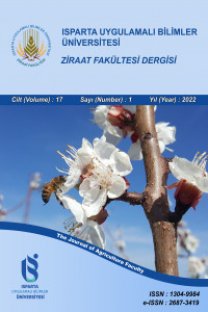Tohum Yatağı Hazırlığında Tapan Kullanımının Topraktan CO2 Çıkışına Etkisi
Sera oluşumuna etkili gazların miktarı, insan aktiviteleri sonucu son yıllarda daha da artmıştır. Bu aktiviteler; endüstriyel, tarımsal ve fosil yakıt kullanımını içeren çalışmalardır. Tarımsal çalışmalarda üretilen sera gazları; CO2, NH4 ve N2O gazlarıdır. Bu gazlar içerisinde en fazla üretileni karbondioksit gazıdır. Toprak ekosistemi özelliklerine bağlı olarak topraktan salınan CO2 miktarı değişmektedir. Bu özelliklerden en önemlileri; toprak nemi, organik madde miktarı, toprak sıcaklığı ve toprağın havalandırılma derecesidir. Bu çalışmada sırasıyla; 0 (P0), 45 (P45) ve 60 (P60) kg ağırlığında tapanlar kullanılarak tohum yatağı hazırlanmıştır. Daha sonra, CO2 çıkışı ve toprak fiziksel özellikleri saptanmıştır. Elde edilen verilere göre; CO2 çıkışı; g m-2 h-1 olarak en çoktan aza doğru sırasıyla, tapansız P0 (0.104), P45 (0.043) ve P60 (0.037) uygulamaları birbirini izlemiştir. P0 ‘da (P
Anahtar Kelimeler:
Topraktan CO2 çıkışı, tohum yatağı hazırlığı, sera gazı etkisi, tapan,
The Effect of Scrapper Use on Soil CO2 Emission during the Seedbed Preparation
As a result of human activities in recent years, the amount of greenhouse gases has increased dramatically. These are industrial and agricultural activities including the use of fossil fuels. Greenhouse gases produced in the agricultural activities are CO2, NH4, and N2O. CO2 is the most produced gas among the greenhouse gases. The amount of CO2 flux from soil varies depending on the soil ecosystem properties. The most important of these features are soil moisture, amount of organic matter, soil temperature, and the degree of soil aeration. In this study; a scrapper loaded with different weight of 0 (p0), 45 (P45) and 60 (P60) kilogram was used to prepare the seedbed. Then, the CO2 flux and soil physical properties were determined. According to the data obtained; CO2 flux (g.m-2.h-1) was 0.104, 0.043, and 0.037 for P0, P45,, and P60 respectively. P0 application produced more CO2 than the other two applications (P
Keywords:
Soil CO2 emission, seedbed preparation, green house gas effect, scrapper.,
___
- Akbolat, D., Ekinci, K., Camcı Çetin S., Çoşkan, A. 2004. Farklı Toprak İşleme Sistemlerinin Toprakta Organik Maddenin Ayrışmasına Etkisi. Süleyman Demirel Üniversitesi Fen Bilimleri Enstitüsü Dergisi 8, 152-160.
- Akbolat, D., Evrendilek, F. Coşkan A., Ekinci, K. 2009. Quantifying soil respiration in response to short-term tillage practices: a case study in southern Turkey. Acta Agriculturae Scandinavica Section B Soil & Plant Science 59, 50-56.
- Ball, BC., Crichton I., Horgan, GW. 2008. Dynamics of upward and downward N2O and CO2 fluxes in ploughed or no-tilled soils in relation to water-filled pore space, compaction and crop presence. Soil Tillage Research, 101, 20-30.
- Ball, BC., Scott A., Parker, JB. 1999. Field N2O, CO2 and CH4 fluxes in relation to tillage, compaction and soil quality in Scotland. Soil Tillage Research 53, 29-30.
- Blake, GR., Hartge, KH. 1986. Bulk density. In: Klute A ed. Methods of soil analysis. Part I. Physical and minerological methods. Agronomy Monographs 9. American Society of Agronomy (ASA) and Soil Science Society of America (SSSA), Madison, Wisconsin. Pp. 363–375.
- Blanke, MM. 1996. Soil Respiration in an Apple Orchard. Environmental and Experimental Biology, vol 36 pp 339-348.
- Claderon, F., Jackson, LE. 2002. Rototillage, disking, and subsequent irrigation: Effects on soil nitogen dynamics, microbial biomass, and carbon dioxide efflux. J. Environmental quality, 31, 752-758.
- Danielson, RE., Sutherland, PLI. 1986. Porosity. A ed. of soil analysis. Part I. Physical and minerological methods. 2nd ed. Agronomy 9. American Society of Agronomy (ASA) and Soil Science Society of America (SSSA), Wisconsin. Pp. 443–461.
- Haktanır, K., Arcak, S. 1997. Toprak Biyolojisi. Ankara Üniversitesi (1486), Ziraat Fakültesi (447) Yayınları ANKARA.
- Jensen, LS., McQueen, DJ., Shepherd, TG. 1999. Effect of soil compaction on N-mineraliaztion and microbial-C ans –N. I. Field measurement. Soil & tillage research, 38, 175-188.
- Karatepe, M. 2000. SDÜ Çiftlik Topraklarının Elverişli Bazı Bitki Besin Elementleri Dağılımının Araştırılması, Yüksek lisans Tezi, SDÜ. Fen Bilimleri Enstitüsü, Toprak Anabilim dalı, ISPARTA.
- Lal R., Kimbele, JM. 1997. Conservation Tillage for Carbon Sequestration. Nutrient Cycling in Agroecosystems 49: 243-253.
- Önal, İ. 1995. Ekim, bakım ve gübreleme makineleri. Ege üniversitesi ziraat fakültesi yayınları No: 490, Bornova-İzmir
- Reicosky, DC. 2003. Tillage-induced CO2 emissions and carbon sequestration: effect of secondary tillage and compaction. Ed. L. García-Torres, J. Benites, A. Martínez-Vilela, and A. Holgado-Cabrera. (source); conservation agriculture: environment, farmers expriences, innovations, socio-economy. Springer; 1 edition, 516, 291-300.
- Reicosky, DC., Archer, DW. 2007. Moldboard plow tillage depth and short-term carbon dioxide release. Soil & Tillage Research, 94, 109-121.
- Sainju, UM., Jabro JD., Stewens, WB.2006. Soil Carbon Dioxide Emission as Influenced by Irrigation, Tillage, Cropping System, and Nitrogen Fertilization. Workshop on Agricultural Air Quality, pp (1086-1098). USDA-ARS-NPARI, 1500 North Central Avenue, Sidney.
- SAS, 1999. Statistical Analysis Program.
- Smith, KA., T. Ball, F. Conen, KE. Dobie, J. Massheder ve A. Rey, 2003. Exchange of Greenhouse Gasses between Soil and Atmosphere: Interactions of Soil Physical Factors and Biological Processes. European Journal of Soil Science, 54, 779-791.
- ISSN: 1304-9984
- Yayın Aralığı: Yılda 2 Sayı
- Başlangıç: 2006
- Yayıncı: Isparta Uygulamalı Bilimler Üniversitesi
Sayıdaki Diğer Makaleler
Isparta İli Pancar Ekim Alanlarında Fungal Hastalıkların ve Yaygınlık Oranlarının Belirlenmesi
Hülya ÖZGÖNEN, Handan ÇULAL KILIÇ
Tohum Yatağı Hazırlığında Tapan Kullanımının Topraktan CO2 Çıkışına Etkisi
MUSTAFA SAKALDAŞ, Canan Öztokat KUZUCU, KENAN KAYNAŞ
Bozovada Yaygın Olarak Yetiştirilen Antepfıstığı (Pistacia vera L.) Ağaçlarının Beslenme Durumu
İlhan KIZILGÖZ, Ece TUTAR, ERDAL SAKİN
Isparta ili şekerpancarı ekim alanlarında fungal hastalıkların ve yaygınlık oranlarının belirlenmesi
HÜLYA ÖZGÖNEN ÖZKAYA, HANDAN ÇULAL KILIÇ
